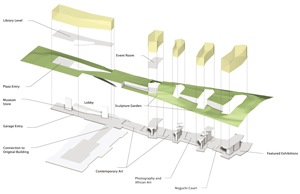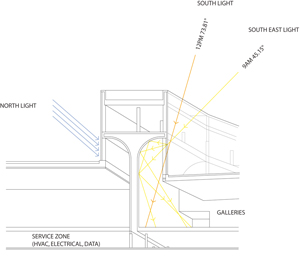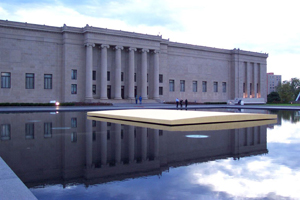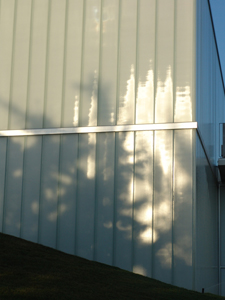 |
 |
 |
 |
 |
 |
| |
 |
|
 |
 |
 |
  |
  |
 |
 |
 |
 |
|
|
 |
|
 |
 |
 |
BUILDING |
 |
|
 |
|
 |
 |
 |
| |
 |
| 
 |
Nelson Atkins Museum of Art - Expansion and Renovation
|
|
 |
 |
 |
 |
DESIGNER |
 |
|
|
 |
|
 |
 |
 |
| |
 |
|
 |
 |
 |
 |
DESCRIPTION |
 |
|
|
 |
|
 |
 |
 |
|
|
 |
 The expansion of The Nelson-Atkins Museum of Art fuses architecture with landscape to create an experiential architecture that unfolds for visitors as it is perceived through each individual’s movement through space and time. The new addition, named the Bloch Building, engages the existing sculpture garden, transforming the entire Museum site into the precinct of the visitor’s experience. The new addition extends along the eastern edge of the campus, and is distinguished by five glass lenses, traversing from the existing building through the Sculpture Park to form new spaces and angles of vision. The innovative merging of landscape, architecture and art was executed through close collaboration with museum curators and artists, to achieve a dynamic and supportive relationship between art and architecture. The expansion of The Nelson-Atkins Museum of Art fuses architecture with landscape to create an experiential architecture that unfolds for visitors as it is perceived through each individual’s movement through space and time. The new addition, named the Bloch Building, engages the existing sculpture garden, transforming the entire Museum site into the precinct of the visitor’s experience. The new addition extends along the eastern edge of the campus, and is distinguished by five glass lenses, traversing from the existing building through the Sculpture Park to form new spaces and angles of vision. The innovative merging of landscape, architecture and art was executed through close collaboration with museum curators and artists, to achieve a dynamic and supportive relationship between art and architecture.
As visitors move through the new addition, they will experience a flow between light, art, architecture and landscape, with views from one level to another, from inside to outside. The threaded movement between the light-gathering lenses of the new addition weaves the new building with the landscape in a fluid dynamism based on a sensitive relationship to its context. Rather than an addition of a mass, the new elements exist in complementary contrast with the original 1933 classical “Temple to Art”:
___Original Building_______New (in Complementary Contrast)
___Opaque _____________Transparent
___Heavy_______________Light
___Hermetic_____________Meshing
___Inward views_________ Views to landscape
___Bounded____________ Unbounded
___Directed Circulation____Open Circulation
___Single Mass__________Transparent lenses
The first of the five “lenses” forms a bright and transparent lobby, with café, art library and bookstore, inviting the public into the Museum and encouraging movement via ramps toward the galleries as they progress downward into the garden. From the lobby a new cross-axis connects through to the original building’s grand spaces. At night the glowing glass volume of the lobby provides an inviting transparency, drawing visitors to events and activities.
The lenses’ multiple layers of translucent glass gather, diffuse and refract light, at times materializing light like blocks of ice. During the day the lenses inject varying qualities of light into the galleries, while at night the sculpture garden glows with their internal light. The “meandering path” threaded between the lenses in the Sculpture Park has its sinuous complement in the open flow through the continuous level of galleries below. The galleries, organized in sequence to support the progression of the collections, gradually step down into the Park, and are punctuated by views into the landscape.
 The design for the new addition utilizes sustainable building concepts; the sculpture garden continues up and over the gallery roofs, creating sculpture courts between the lenses, while also providing green roofs to achieve high insulation and control storm water. At the heart of the addition’s lenses is a structural concept merged with a light and air distributor concept: "Breathing T's” transport light down into the galleries along their curved undersides while carrying the glass in suspension and providing a location for HVAC ducts. The double-glass cavities of the lenses gather sun-heated air in winter or exhaust it in summer. Optimum light levels for all types of art or media installations and seasonal flexibility requirements are ensured through the use of computer-controlled screens and of special translucent insulating material embedded in the glass cavities. A continuous service level basement below the galleries offers art delivery, storage and handling spaces, as well as flexible access to the "Breathing- Ts." The design for the new addition utilizes sustainable building concepts; the sculpture garden continues up and over the gallery roofs, creating sculpture courts between the lenses, while also providing green roofs to achieve high insulation and control storm water. At the heart of the addition’s lenses is a structural concept merged with a light and air distributor concept: "Breathing T's” transport light down into the galleries along their curved undersides while carrying the glass in suspension and providing a location for HVAC ducts. The double-glass cavities of the lenses gather sun-heated air in winter or exhaust it in summer. Optimum light levels for all types of art or media installations and seasonal flexibility requirements are ensured through the use of computer-controlled screens and of special translucent insulating material embedded in the glass cavities. A continuous service level basement below the galleries offers art delivery, storage and handling spaces, as well as flexible access to the "Breathing- Ts."
 The ingenious integration of art and architecture included a collaborative effort with artist Walter De Maria, one of the great minimalist artists of our time. De Maria’s sculpture, One Sun /34 Moons, is the centerpiece of the expansive granite-paved entrance plaza with a reflecting pool that forms a new entry space shaped by the existing building and the new Lobby “Lens”. The “moons” of the art work are circular skylight discs in the bottom of the pool that project water-refracted light into the garage below. Conceived as a vehicular Arrival Hall, the garage is generously proportioned, directly connected to the new museum lobby on both levels, and spanned with continuous undulating vaults by an innovative pre-cast concrete ‘wave-T’. The ingenious integration of art and architecture included a collaborative effort with artist Walter De Maria, one of the great minimalist artists of our time. De Maria’s sculpture, One Sun /34 Moons, is the centerpiece of the expansive granite-paved entrance plaza with a reflecting pool that forms a new entry space shaped by the existing building and the new Lobby “Lens”. The “moons” of the art work are circular skylight discs in the bottom of the pool that project water-refracted light into the garage below. Conceived as a vehicular Arrival Hall, the garage is generously proportioned, directly connected to the new museum lobby on both levels, and spanned with continuous undulating vaults by an innovative pre-cast concrete ‘wave-T’.
A strong relationship between the architectural concept and the Museum’s important oriental art holdings is illustrated by works in the permanent collection such as Verdant Mountains (12th century) by Chiang Shen or The North Sea (16th century) by Chou Ch'en, which demonstrate the timeless merging of art, architecture and landscape. The new addition celebrates this fusion with the new Isamu Noguchi Sculpture Court, setting a binding connection to the existing Sculpture Gardens. |
|
 |
 |
 |
|
 |
|
| Landscape Design |
 |
|
 |
The lenses are woven into the landscape of the 22-acre Sculpture Park, and space between the lenses will feature simple ground covering on the gallery roofs, including grass and low shrubs. This green roof system manages storm water and provides high insulation value and thermal mass to the building, significantly reducing energy consumption. Trees planted along the east edge of the campus will complement the Bloch Building, and at their maturity they will continue to accent rather than obscure the lenses. Plantings also will be integrated into the south end of the campus, where the landscape descends into a more naturalistic style setting.
Courtesy by Steven Holl Architects |
|
 |
 |
 |
 |
 |
 |
 |
MATERIALS |
 |
|
|
 |
|
 |
 |
 |
 |
 |
|
glass, steel, reinforced concrete  The five “lenses” are made of a double layer glass assembly with pressurized air cavity between the layers. The outer layer consists of double interlocked glass plank with OKALUX translucent insulation in-between. The inner layer is translucent laminated low iron glass, with an acid etch finish. (More than 6,000 planks of ¼- inch translucent, sandblasted U-profile channel glass form a double- glass cavity; laminated acid-etched flat glass and clear flat glass). The channel and laminated glass provide modified, diffused natural light into the galleries and the clear glass offers open views of the Sculpture Park at various points in the galleries and halls. Other flat glass in the project, between the lenses, consists of several configurations of insulated glass units, all made with low iron glass, including configurations with low-e coatings, acid etched surfaces and OKALUX insulation. The five “lenses” are made of a double layer glass assembly with pressurized air cavity between the layers. The outer layer consists of double interlocked glass plank with OKALUX translucent insulation in-between. The inner layer is translucent laminated low iron glass, with an acid etch finish. (More than 6,000 planks of ¼- inch translucent, sandblasted U-profile channel glass form a double- glass cavity; laminated acid-etched flat glass and clear flat glass). The channel and laminated glass provide modified, diffused natural light into the galleries and the clear glass offers open views of the Sculpture Park at various points in the galleries and halls. Other flat glass in the project, between the lenses, consists of several configurations of insulated glass units, all made with low iron glass, including configurations with low-e coatings, acid etched surfaces and OKALUX insulation.
Concrete slabs and Retaining walls, steel framing and steel trusses, concrete slabs on metal deck comprise the structural envelope.
Computer controlled screens within the cavity ensure the efficiency and seasonal day lighting flexibility for the lenses.
Floors in public areas are terrazzo with recycled glass aggregate. Floors in Galleries is stained end-grain red oak block, terrazzo and granite.
Wall finishes in public areas is polished plaster. Wall finishes in galleries is a level 5 finish gypsum board on vertical walls and gypsum plaster on vaulting in the lenses. Bases are pre-cast terrazzo and stainless steel. Glass railings are acid etched low iron glass. Metal railings and hardware are bead blasted Stainless Steel. Public elevator interior surfaces are translucent honeycomb panels with bead blasted stainless steel hardware.
Ceilings in public areas are acoustic plaster and in the Galleries painted gypsum board. Perforated wood acoustic ceilings are utilized in the larger meeting rooms.
Lighting throughout the project is a custom designed combination of indirect cove lighting, intermittent (‘stitch’) track incandescent lighting and recessed linear fluorescent fixtures. Lighting is designed to balance color and intensity between natural light from the lenses and electric lighting, providing the Museum with maximum flexibility and control throughout the project.
Courtesy by Steven Holl Architects
|
|
 |
 |
 |
 |
ECO-SUSTAINABILITY |
 |
|
|
 |
|
 |
 |
 |
|
|
 |
 Stormwater Management Stormwater Management
The Nelson-Atkins New Building has green roofs contiguous with the landscape, providing a natural storm water system. Paved area is decreased by replacing ongrade parking with a below grade garage. There is no net increase in the rate of quantity of stormwater run off from existing undeveloped condition.
Indoor Environmental Quality
For sustainability goals and artwork conservation, all materials, including paints, sealants, carpets and adhesives have zero or very low-VOC emittance. IAQ is an important consideration for the museum’s collection as well as the occupants’ comfort. In addition to strict ventilation and conditioning requirements during construction to reduce the possibility of trapping trace amounts of VOC’s, the building will undergo a two step commissioning process. After the initial commissioning has been complete, the filters will be changed and the building systems will be re-commissioned and run for an extended period of time to flush out any remaining odors, traces of VOC’s, or other irritants. Extensive temperature and humidity monitoring maintains thermal comfort and art conservation conditions. More than 75% of spaces are daylit.
Materials & Resources
100% of shell/structure and 50% of non-shell/structure of existing building is maintained. The new building terrazzo floor is specified with recycled glass aggregate. Gallery floors are of FSC-certified wood. Local concrete plants provide precast and cast-in-place concrete which constitute more than 30% of the overall building materials thus the environmental impact resulting from material transportation.
Renewable Energy/Green Power
Lens air cavities are conditioned with the building's exhaust air. Enthalpy wheels located in intake and exhaust air paths reuse building energy.
High Performance Building Systems
Existing Central Plant is completely refitted with new energy efficient equipment serving both existing and new buildings without a net increase over current existing building-only energy consumption. New Building and retrofitted existing building systems use no CFC refrigerants, HCFC’s or Halons. HVAC systems will undergo a comprehensive year-long commissioning and verification period to optimize performance.
Energy Flows
The combination of the High insulating Green roof and Below-grade construction with large thermal mass reduces the energy needed to maintain the strict environmental criteria of the exhibition galleries. Five “lenses” constructed of a double skin glass assembly provide maximum natural light allowable for art conservation while minimizing heat gain in summer; and harnessing solar gain and reducing heat loss in winter. “Lens” assembly consists of exterior layer of double plank glass with OKALUX translucent insulation, pressurized air cavity, sealed inner laminated glass layer. Garage is naturally lit by skylights, reducing daytime electrical consumption.
Water Efficient Landscape
Plant types and species are indigenous or adaptive to the local climate, and require minimum maintenance.
Light Pollution Reduction
Low level site lighting is provided entirely by spill from building's interior lighting.
Landscape and Exterior Design/Heat Island Prevention
Trees/bushes provide shading throughout the landscape for paths, terraces and vision glass areas. 50,000sf of green (vegetated) roof (overall 12" thick) increases the insulation R value by 3 points and reduces stormwater run-off. White membrane roofing of “lenses” reduces heat absorption. Deep canopies shade west-facing vision glass. There is minimal heat island effect.
Courtesy by Steven Holl Architects |
|
 |
 |
 |
 |
 |
 |
 |
LOCATION |
 |
|
|
 |
|
 |
 |
 |

|
 |

|
Continent |
|
 |
  North America |
|
Nation |
|
 |
  United States |
|
State |
|
 |
  Missouri |
|
County |
|
 |
  Clay |
|
Town |
|
 |
  Kansas City |
|
Address |
|
 |
  4525 Oak Street - Kansas City, Missouri 64111-1873
|
|
|
|
 |
|
Telephone |
|
 |
|
Fax |
|
 |
|
Website |
|
 |
|
 |
 |
 |
 |
|
TYPOLOGY |
 |
|
|
 |
|
 |
 |
 |
Main |
 |
|
 |
ARCHITECTURE | Buildings for cultural activities
Art galleries and exhibition areas
Museums and buildings for exhibitions
Art museums
Operations on existing buildings
Renovation, rehabilitation and restructuring
Extension, superelevation
|
LANDSCAPE ARCHITECTURE AND NATURAL ENVIRONMENTS | Landscape architecture
Private parks
| |
|
|
 |
|
Additional |
 |
|
 |
ARCHITECTURE | Buildings for cultural activities
Libraries and media libraries
Conference halls
Buildings for offices and professional practises
Offices
Commercial buildings
Bars, cafeterias
Transport buildings and structures
Garages, car parking, etc.
| |
 |
 |
 |
 |
CHRONOLOGY |
 |
|
|
 |
|
 |
 |
 |
Project |
 |
|
 |
| 
 |
1997 - 1999
project winner of competition
|
|
Realisation |
 |
|
 |
| 
 |
2001 - 2007 |
|
 |
 |
 |
 |
AWARDS |
 |
|
|
 |
|
 |
 |
 |
| 2008 |
 |
|
 |
| AIA Institute Honor Award for Architecture |
|
 |
 |
 |
 |
 |
 |
 |
BIBILIOGRAPHIC REFERENCES |
 |
|
|
 |
|
 |
 |
 |
|
 |
Paul Goldberger, "Hielo en la hierba. Holl reinventa el género de la ampliación museística", Arquitectura Viva 111, noviembre-diciembre/november-december 2007, "Últimos proyectos. Técnica/Diseño" pp. 106-107 (104-121)
Steven Holl, "Luces en la colina. Ampliación del Museo Nelson-Atkins, Kansas City", Arquitectura Viva 111, noviembre-diciembre/november-december 2007, "Últimos proyectos. Técnica/Diseño" pp. 116-121 (104-121) |
|
|
| "Museum in Kansas City", Detail 10/2007 [Transluzente Materialen/Translucent Materials/Translucidité], "Dokumentation/Documentation" pp. 1114-1120 |
|
|
| Raymund Ryan, "Steven Holl in Kansas City", The Plan 21, agosto-settembre/august-september 2007, "Letter from America" pp. 103-112 |
|
|
| Marco Borsotti, "5 «lenti» per un percorso ipogeo", Il giornale dell'architettura 53, luglio-agosto 2007, p. 25 |
|
|
"Steven Holl. Nelson Atkins Museum of Art. Kansas City", Casabella 757, luglio-agosto/july-august 2007, "Spazi per il pubblico" pp. 14-25, 91-92
Marco Biraghi, "Incroci e divaricazioni. Nell'ottica di Steven Holl/Intersections and forks. The oulook of Steven Holl", Casabella 757, luglio-agosto/july-august 2007, "Spazi per il pubblico" pp. 15, 18-19, 91-92 (14-25, 91-92) |
|
|
"Grand Trasparent", Domus 904, giugno/june 2007, pp. 12-25
Steven Holl, Domus 904, giugno/june 2007, pp. 14-15 (12-25)
Michael Cadwell, "La pietra e la piuma/Stone and feather", Domus 904, giugno/june 2007, pp. 24-25 (12-25) |
|
|
| Stefano Casciani, "Avventure nel regno tattile/Adventures in the Haptic Realm", Domus speciale. Dentro la materia e oltre/Into the matter and beyond, allegatoa/published with Domus 902, aprile/april 2007, pp. 32-39 |
|
|
| Peter Sobchak, "Es werde Licht! - Licht und Raum in neuen amerikanischen Museen/Let there be light - Light and Space in New American Museums", Detail 4/2006 [Licht und Innenraum/Light and Interiors/Éclairage et intérieurs], "Diskussion/Discussion" pp. 290-293, 296 (290-298) |
|
|
| Matteo Zambelli, "Architettura Forma Paesaggio/Landform Architecture", L'industria delle costruzioni 374, novembre-dicembre/november-dicember 2003 [Architettura forma paesaggio], p. 31 (4-33) |
|
|
"Steven Holl. Bellevue Art Museum, Bellevue. Nelson Atkins Museum, Kansas City. Kiasma, Helsinki", Lotus Navigator 6, settembre/september 2002 [L'espansione dell'arte/The expansion of art], pp. 46-71
"Nelson Atkins Museum of Art", Lotus Navigator 6, settembre/september 2002 [L'espansione dell'arte/The expansion of art], pp. 56-63 (46-71) |
|
|
| "Steven Holl Architects. Nelson Atkins Museum of Art, Kansas" in Next. 8. Mostra Internazionale di Architettura. 2002, Marsilio, Venezia 2002, "Musei" pp. 118-121 |
|
|
| Domus 822, gennaio/january 2000 [Dopo il 2000/After 2000], Notizie/News IV |
|
 |
 |
 |
 |
 |
 |
 |
CLIENT |
 |
|
|
 |
|
 |
 |
 |
| |
 |
| Nelson Atkins Museum of Art |
|
 |
 |
 |
 |
AMOUNT |
 |
|
|
 |
|
 |
 |
 |
| |
 |
|
 |
 |
 |
 |
DIMENSIONAL
DATA |
 |
|
|
 |
|
 |
 |
 |
| Surface |
 |
|
 |
addition sq.m. 15.329 (sq.ft. 234.000)
renovation sq.m. 21.739 (sq.ft. 234.000)
garage sq.m. 42 (sq.ft. 450)
Size Sculpture Park ha. 9 (22 acres) |
|
| Height |
 |
|
 |
addition ml. 12,80 (ft. 42) above grade
original building ml. 16,76 (ft. 55) |
|
| Depth |
 |
|
 |
| addition m. 9,75 (ft. 32) below grade |
|
| Lenght |
 |
|
 |
addition m. 256 (ft. 840)
original building m. 94 (ft. 310) |
|
| Dimensions |
 |
|
 |
| Reflecting Pool m. 41 x 49 (ft. 134 x 161) |
|
| Capacity |
 |
|
 |
| Reflecting Pool m³ 454 (gallons 120,000) |
|
| Capacity |
 |
|
 |
|
| Floors |
 |
|
 |
addition 4
parking 2 levels |
|
 |
 |
 |
 |
STRUCTURES |
 |
|
|
 |
|
 |
 |
 |
| |
 |
| Guy Nordenson & Associates |
|
 |
 |
 |
 |
LANDSCAPE DESIGN |
 |
|
|
 |
|
 |
 |
 |
| |
 |
Gould Evans Associates, Kansas City
Olin Partnership, Philadelphia |
|
 |
 |
 |
 |
STAFF |
 |
|
|
 |
|
 |
 |
 |
Project  |
 |
|
|
 |
|
|
 |
|
Design architects |
 |
|
Principal-in-charge |
 |
|
Project architect |
 |
| Martin Cox, Richard Tobias |
|
Design team |
 |
| Masao Akiyoshi, Gabriela Barman-Kraemer, Matthias Blass, Molly Blieden, Elissavet Chryssochoides, Robert Edmonds, Simone Giostra, Annette Goderbauer, Mimi Hoang, Makram El-Kadi, Edward Lalonde, Li Hu, Justin Korhammer, Linda Lee, Fabian Llonch, Stephen O'Dell, Irene Vogt, Urs Vogt, Christian Wassmann |
|
Architect of record |
 |
| BNIM - BerkebileNelson Immenschuh McDowell Architects |
|
Structural consultant |
 |
| Structural Engineering Associates |
|
Systems |
 |
Ove Arup & Partners
W.L. Cassell Associates |
|
Glazing consultant |
 |
| R.A. Heintges & Associates |
|
Lighting consultant |
 |
|
Art intervention |
 |
|
 |
  |
 |
|
|